As of today, 12-5-14, Dirt Time at Dahlem has a new address: www.thedahlemcenter.blogspot.com
The adventure continues! Hope to see you there!
As of today, 12-5-14, Dirt Time at Dahlem has a new address: www.thedahlemcenter.blogspot.com
The adventure continues! Hope to see you there!
Due to difficulties with WordPress, we are moving our blog over to Blogspot. You can now read Dirt Time at Dahlem at www.dahlemcenter.blogspot.com. See you there!
August 8 & 9 found us hosting our third Hunger Games here at Dahlem. As usual, Friday is the day we spend training the participants in a variety of outdoor skills, which they must demonstrate with a certain level of competence the next day in order to acquire food, water or bug spray.
We had 22 kids, ages 11-17, sign up, and a whole passel of volunteers (and staff) to help make the games a success, either teaching and testing the skills, or walking the perimeter of the Arena on Saturday. These are the unsung heroes (and heroines) who make so many of our programs possible, and we couldn’t have done it without them.
Bob spent the first part of the morning teaching basic knots, knife safety, and first aid.
Then we headed outdoors, where Michael did a wonderful demonstration of how to set a couple different types of snares.
This was followed by a hands-on demo on fire-building, both with a bow drill and a hand drill. The kids found out it isn’t quite as easy as it looks!
From there we moved on to shelter-building. Each team had to build a weather-proof shelter. Some were more successful than others, but they all had a good time, especially when we had them tear them down afterwards.
Our next stop was a visit with Pat, who demonstrated different techniques for gathering water. It’s a good thing we had water available for the kids, because if one had to count on these methods, one would probably get very thirsty waiting for enough moisture to collect to fill one’s mouth. Still…it is a great skill to know…just in case!
We taught them how to make cordage. We cheated a bit, though, by starting off with raffia, rather than having to gather fibers directly from plants. Still, many of the kids found this to be quite challenging.
Those who were return players couldn’t wait for the camouflage and sneaking training! It seems to always be very popular with the girls…not so much so for the boys. Go figure!
Some REALLY got into it!
When Saturday arrived, we started off with a group shot…everyone nice and clean and eager to begin.
We had a new Arena this year, which had a lot more open space. The starting point, the Cornucopia, was in the grassland. The six skills stations were scattered through the Arena. At the beginning, everyone was 50 feet from the Cornucopia, and when the horn blew, the charge began!
I did not get many shots of the action this time around…I was always in the wrong place at the wrong time. I got one video, and it will cause motion sickness if I post it, so you will just have to use your imagination, picturing people in pink running through the woods and fields trying to keep their bandanas from being captured by their pursuers!
Halle does her best to demonstrate snares.
Bob tested both knots and first aid.
Gary ran the cordage station…and watched birds.
The fire skills station was so well hidden that Holly only got one person to stop by for testing! Pat’s water station, also in the grasslands, had a good number of visitors.
This year we ended up with five “winners,” whose names all went into a hat and one was drawn as THE winner. Congratulations Maddie Girard!
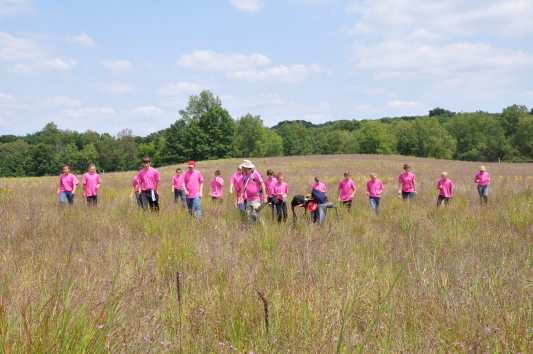 We’ll be doing the Hunger Games again next August. Hope to see you there!
We’ll be doing the Hunger Games again next August. Hope to see you there!
We had a mystery flower out in the fen, so we had to go out and try to identify it, right? It was cloudy and looked like it could threaten rain at any moment, but regardless, we piled into the golf cart and headed out.
Along the way to the fen, we encountered some other flowers, like this lance-leaved loosestrife. It’s a lovely little yellow flower, and one that can be easily over-looked if one isn’t paying attention. Look for it in the open area by the shelter just before the grasslands.
 Right now our native bee balm, or monarda, is coming into its own. The fields all over are just loaded with plants whose buds are ready to burst. Be careful not to confuse it with the spotted knapweed, which is also blooming right now and is the same light lavender color.
Right now our native bee balm, or monarda, is coming into its own. The fields all over are just loaded with plants whose buds are ready to burst. Be careful not to confuse it with the spotted knapweed, which is also blooming right now and is the same light lavender color.
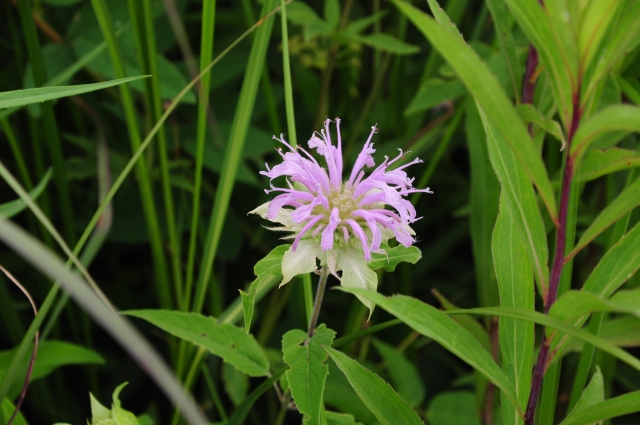
I was very excited by this plant, which is growing in our grasslands right alongside the trail. It is a new life plant for me: colicroot, Aletris farinosa. It’s a member of the lily family, which one would realize easily by the leaves, but the leaves are not “out” right now. They will be visible at the base of the plant later in the season.
 It has a variety of other, very colorful, names, like unicorn root (don’t you love that?), crow-corn and white stargrass. And, it was one of the five original ingredients in Lydia Pinkham’s Vegetable Compound, which was used (until the 1930s) by women who suffered from “female complaints”.
It has a variety of other, very colorful, names, like unicorn root (don’t you love that?), crow-corn and white stargrass. And, it was one of the five original ingredients in Lydia Pinkham’s Vegetable Compound, which was used (until the 1930s) by women who suffered from “female complaints”.
 And just because I find such things interesting, here is a copy of the label from the famous compound. You can still buy the product today, but the formula has changed somewhat. Of the original five ingredients, only two remain, neither of which is colicroot.
And just because I find such things interesting, here is a copy of the label from the famous compound. You can still buy the product today, but the formula has changed somewhat. Of the original five ingredients, only two remain, neither of which is colicroot.
 Another tall white spire of flowers is also in bloom right now: Culver’s root. This plant, too, has a history of medicinal uses; it is known to be high in potassium and magnesium and is used as a relaxer and supposedly has a “tonic effect” on the liver and stomach. Good for diarrhea, purifying the blood, reducing fevers, and syphilitic conditions, according to one website. Bees like it, so that’s a good enough reason to plant it in my book, and it’s native.
Another tall white spire of flowers is also in bloom right now: Culver’s root. This plant, too, has a history of medicinal uses; it is known to be high in potassium and magnesium and is used as a relaxer and supposedly has a “tonic effect” on the liver and stomach. Good for diarrhea, purifying the blood, reducing fevers, and syphilitic conditions, according to one website. Bees like it, so that’s a good enough reason to plant it in my book, and it’s native.
As mentioned the other day, the coneflowers are starting to bloom. Right now the grey-headed coneflowers, with their narrow, back-swept yellow petals, are beginning to dot the grassland.
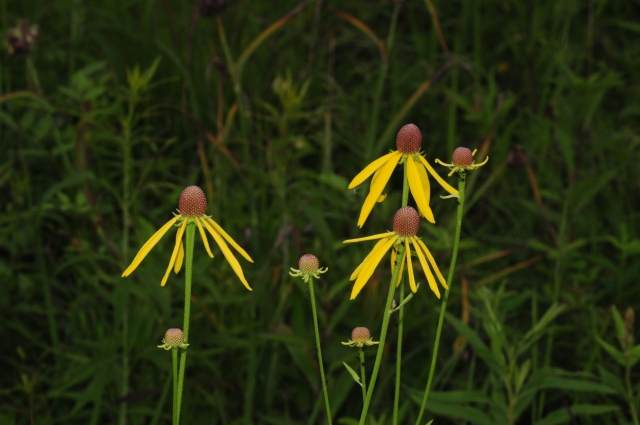 Mmm! If you see this flower, take a leaf, roll it between your fingers and give it a sniff. Ahhh! It will clear your sinuses, and refresh you at the same time. This is narrow-leaved mountain mint, and it’s delightful fragrance will have you coming back for more! Look closely and you will see little purple dots inside each tiny white flower.
Mmm! If you see this flower, take a leaf, roll it between your fingers and give it a sniff. Ahhh! It will clear your sinuses, and refresh you at the same time. This is narrow-leaved mountain mint, and it’s delightful fragrance will have you coming back for more! Look closely and you will see little purple dots inside each tiny white flower.
For lily fanciers, now is the time to go out and see two of our native lilies: the Turk’s cap,
and the Michigan. They look very much alike, and unless you know what to look for, you might not be able to tell them apart. The easiest thing to look for are the stamens – the long dangly parts sticking out from the center of the flower. On the Turk’s cap (above), they extend well past the curved flower petals, while on the Michigan (below), they are much shorter.
Now, this lovely yellow flower is the one that had us going out to the fen. After seeing the other loosestrife earlier, I knew this what what we had here, but it couldn’t be the same species – the leaves are all wrong! It took some searching, but we finally discovered it is narrow-leaved loosestrife, a plant that favors the alkaline conditions of our fens.
I still remain amazed that sundews are in the fen. Apparently they aren’t too picky: acidic bog or alkaline fen, it’s all good to them.
And who wouldn’t be impressed by a flower in a pin-striped suit? I just love this flower – white with green stripes. It is, quite simply, dapper. Grass-of-Parnassus; aka bog-star. Is it a grass (as the name would have you believe)? Nope. It’s in the saxifrage family. No one seems to know why it’s called a grass. It is on the flag of the British county Cumberland, though…just a bit of trivia for you when you go to your next cocktail party.
On the far side of the fen is a tall plant with large yellow flowers. How large – oh, they can be 1-2″ across, these blooms. It is great St. Johnswort, an impressive member of the Hypericum family, and one that is native to our lands (unlike common St. Johnswort, which is not). In some states this wetland plant is threatened or even endangered, but it seems to be doing okay here in Michigan. That said, please do not tramp through our fen to get a close-up look at it! The fen is a fragile ecosystem, and we saw significant evidence today that folks have been tramping through it. Ladies tresses (an orchid), sundews, grass-of-Parnassus…lots of plants were crushed under the trespassers’ feet.
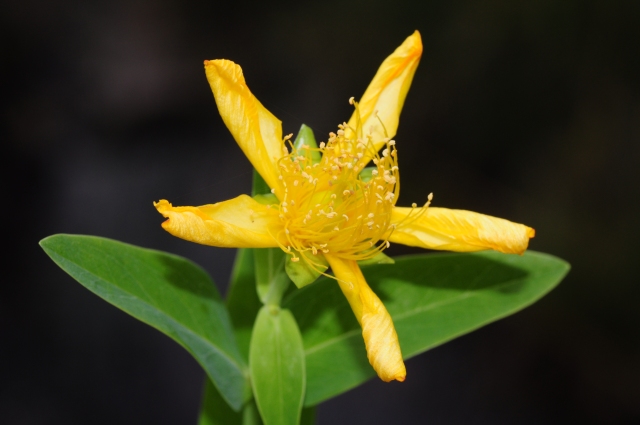 So, here at the midway point of July, with summer in full swing (despite the refreshingly cool temperatures we are enjoying right now), our grassland and fen flowers are getting ready to put on their annual show. Now is the time to come out with your cameras and field guides to enjoy the blooms of the season. While you are at it, bring along your binocs and your dragonfly and butterfly books – there is so much to see in our open spaces!
So, here at the midway point of July, with summer in full swing (despite the refreshingly cool temperatures we are enjoying right now), our grassland and fen flowers are getting ready to put on their annual show. Now is the time to come out with your cameras and field guides to enjoy the blooms of the season. While you are at it, bring along your binocs and your dragonfly and butterfly books – there is so much to see in our open spaces!
It’s time to start exploring the grasslands, here and elsewhere! Summer is in full swing and the grassland flowers are starting to bloom. Along with them, the insects are out and about as well. You just never know what you might encounter. Here is a sample from the last couple of days:
First up, grey tree frogs. I know, they look green, but that’s because they can change color. The really important question, however, is this: are they just plain ol’ ordinary grey tree frogs, or are they Cope’s grey tree frogs? The two species are so difficult to tell apart that even the experts have some difficulty, so of course, I don’t know which these are. But they are very tiny and they are all over the place out on the grasslands – look for them perched on the milkweed leaves. But do leave them there – that is their home.
Last year, Gary and I found one lone green milkweed. We were very excited to see it back this year, but even more excited to find a small patch of them out on the grassland. They are in bloom right now. Not very show, but up close they are lovely…and you can see the definite milkweed flower shape.
And where there are milkweeds, you might just find these! I was so excited to find this monarch caterpillar today!
We saw several monarchs out on the grass land yesterday, and I saw a few again this morning. The one I was able to sneak up on and photograph was looking a bit worse for wear. Her colors were quite faded. I hope she’s laid plenty of eggs!
There were LOTS of these beautiful metallic flies all over the milkweeds. I believe it is a long-legged fly in the genus Condylostylus. Are there any entomologists out there to confirm this?
The Turk’s cap lilies are just starting to open. This one was a bud yesterday. This morning I drove by and it was open. (Drove? On the trails? Yes – I was headed out to the grassland on the golf cart to work at scrubbing paintball paint off the plexiglass of our kiosk; got one panel about 90% cleaned before I had to stop.)
Of course, the common milkweed is blooming all over the place. Milkweeds are great for long-term study. Not only are the flowers fascinating to look at, but the plants are ecosystems in their own right – so many insects call them home!
Yesterday I caught this very dark common wood nymph with the camera. There are lots of them flying around the grasslands – look for very dark butterflies.
This assassin bug is one of the many denizens of the milkweed.
And some of the coneflowers are starting to bloom, too. Right now you can also see spiderwort in bloom, and hoary alyssum (not native) and yarrow (also not native). Oh, and the spotted knapweed is also in bloom (highly invasive non-native) – those are the little purple ones you see in the photo below. The natives are slowly coming along and the season is upon us to make weekly forays out to the grassland to see what’s open.
Earth Day is April 22, officially. When that falls on a weekend, it is great, but when it doesn’t, we make do with the next best thing, and this year that was April 26.
Every year Dahlem joins other Jackson outdoor organizations for an afternoon at Cascades Park to celebrate the wonders of our home: planet Earth.
Here are some highlights from this year’s event:
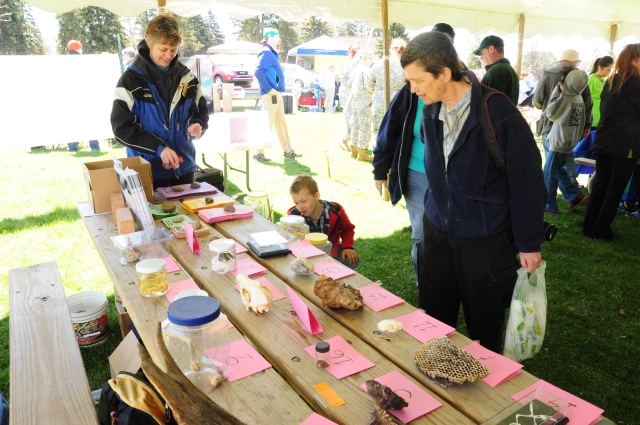 Taking the Naturalist’s Challenge at the Dahlem table.
Taking the Naturalist’s Challenge at the Dahlem table.
 Learning about Geocaching in Jackson.
Learning about Geocaching in Jackson.
 Barefoot Homesteaders shared their knowledge of backyard homesteading.
Barefoot Homesteaders shared their knowledge of backyard homesteading.
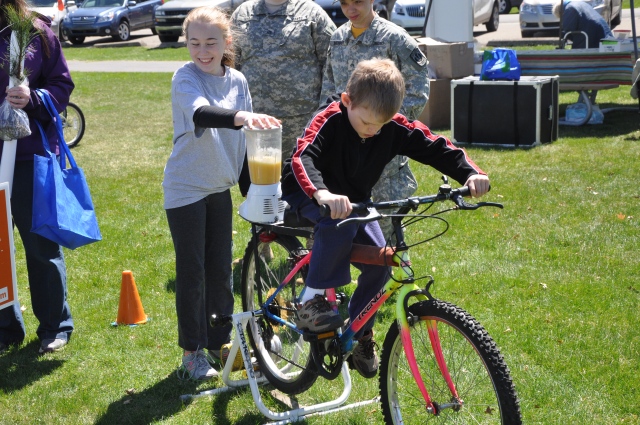 Kids got to make their own slushies with the Fitness Council.
Kids got to make their own slushies with the Fitness Council.
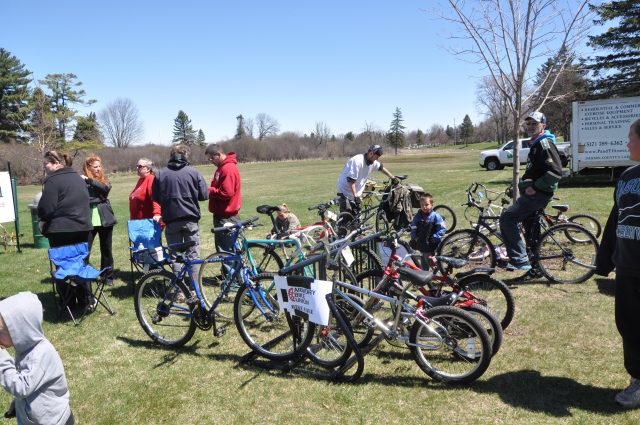 Bicycle Roundup – taking donations of bicycles for those in need.
Bicycle Roundup – taking donations of bicycles for those in need.
 Learning about some of the insects that live in our waterways with the Grand River Watershed Alliance.
Learning about some of the insects that live in our waterways with the Grand River Watershed Alliance.
 Leslie Science and Nature Center shared some of their education birds, like this barred owl.
Leslie Science and Nature Center shared some of their education birds, like this barred owl.
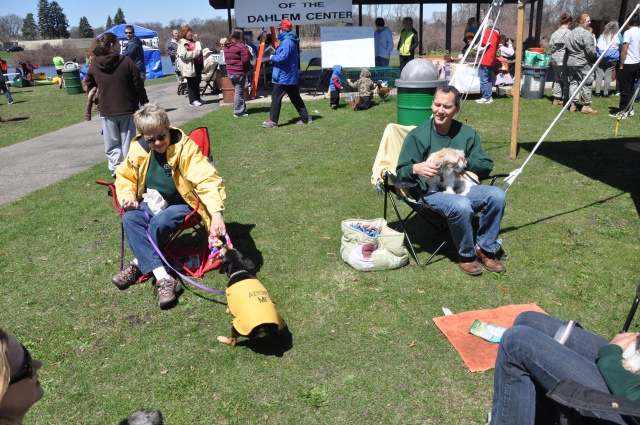 Cascades Humane Society had some of their adoptable dogs with them.
Cascades Humane Society had some of their adoptable dogs with them.
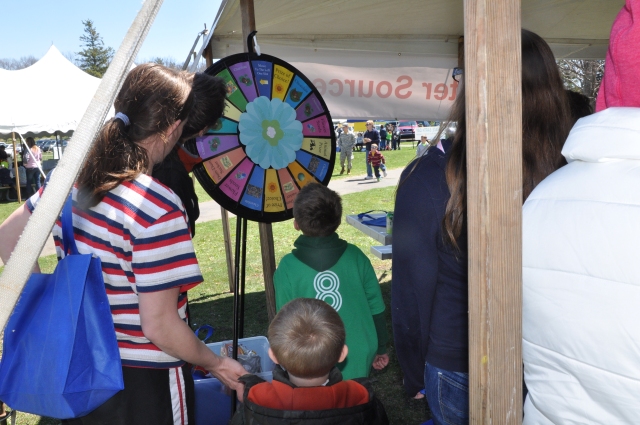 There were lots of games and activities.
There were lots of games and activities.
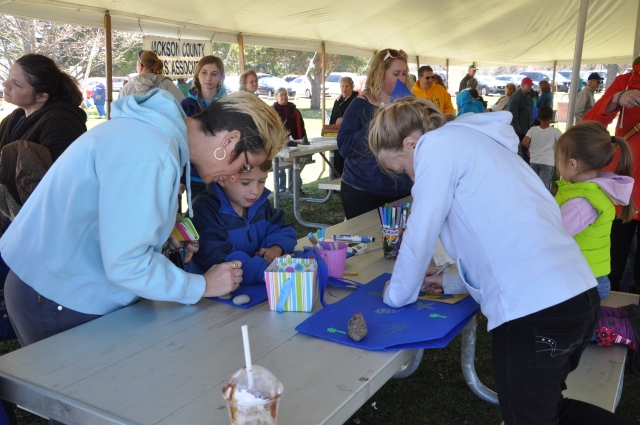
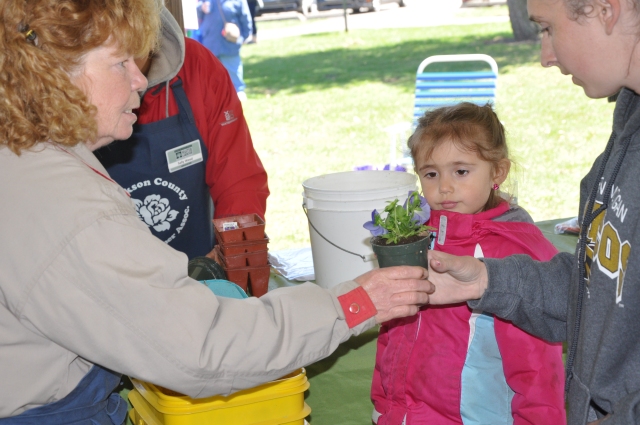
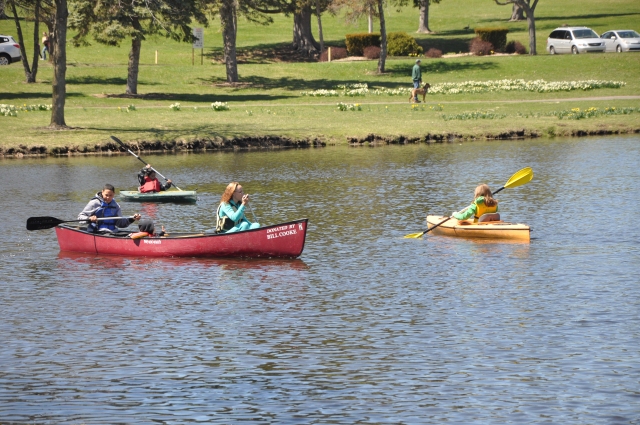 And people could try paddling canoes and kayaks, thanks to the Grand River Environmental Action Team (GREAT). Even this little dog wanted to give it a try!
And people could try paddling canoes and kayaks, thanks to the Grand River Environmental Action Team (GREAT). Even this little dog wanted to give it a try!

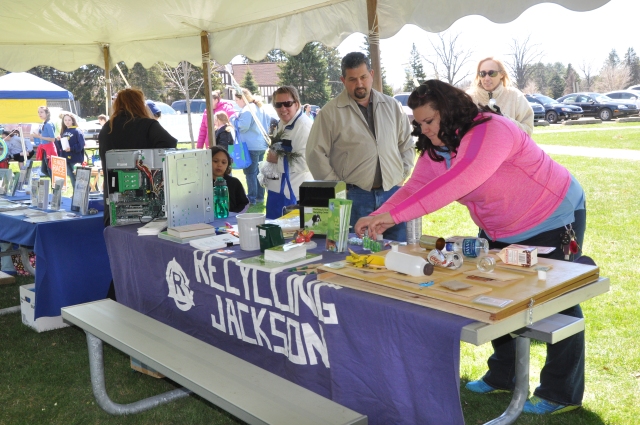 From recycling to how to raise chickens, there was something for everyone!
From recycling to how to raise chickens, there was something for everyone!
Did you miss it this year? Be sure to look for it again next Earth Day! And follow Earth Day Jackson on Facebook!
On mild spring evenings, if you are anywhere near water, you will hear them calling: the love songs of spring peepers, chorus frogs and wood frogs. The males gather in any nearby water and sing for all they are worth to attract the attention of the females who are lingering nearby.
It’s a great time to spend quality together time outdoors with the family. And every spring we offer this opportunity to our visitors as we take them out for Night of the Amphibians.
This year we ran the program two nights: April 24 and 25.
The first night it was a little chilly and overcast. About 16 hardy souls came out and after a quick introduction indoors on what different calls we might hear…
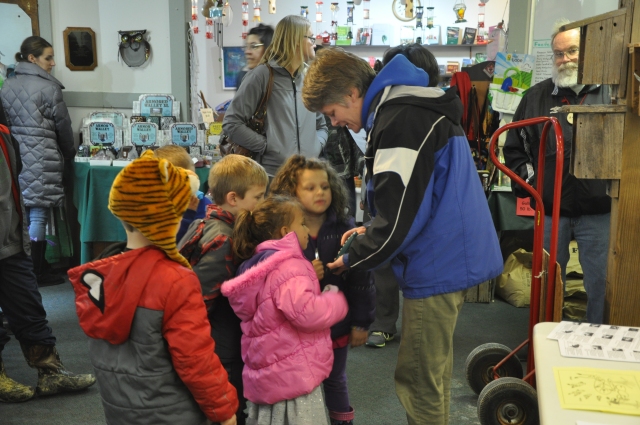 …we gathered nets and collection containers and walked out to the glacial pond.
…we gathered nets and collection containers and walked out to the glacial pond.
 Our first attempts were not too successful. The chilly air was conspiring against us. Even so, the kids sallied forth and gave it their best attempts at searching for frogs.
Our first attempts were not too successful. The chilly air was conspiring against us. Even so, the kids sallied forth and gave it their best attempts at searching for frogs. 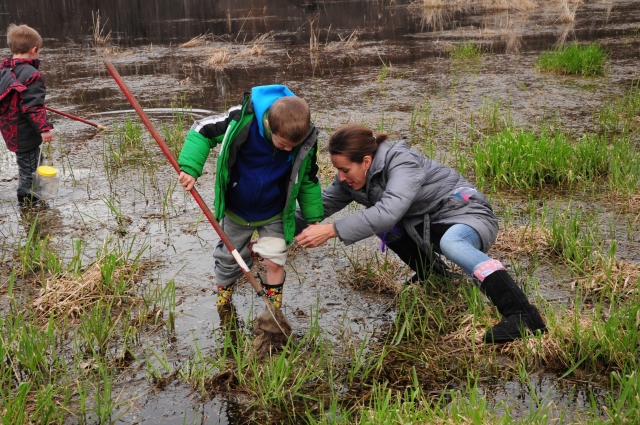

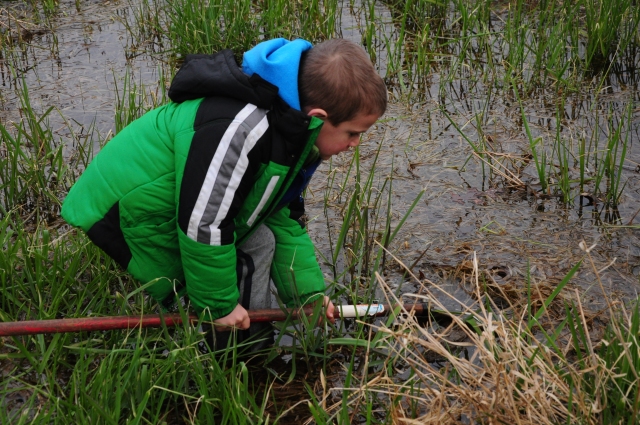 Eventually, as the sun set, we started to hear the peep-peep-peeps of the spring peepers on the far side of the pond. The group waded around the edge and soon had cast aside their nets in favor of grabbing frogs with their bare hands.
Eventually, as the sun set, we started to hear the peep-peep-peeps of the spring peepers on the far side of the pond. The group waded around the edge and soon had cast aside their nets in favor of grabbing frogs with their bare hands.
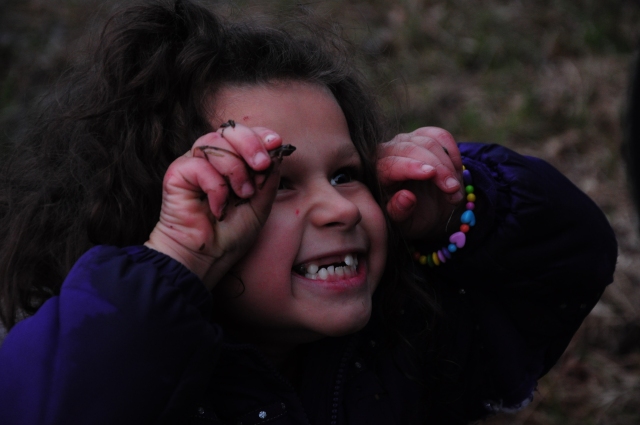 One adventurer caught a very cold painted turtle. We soon put him back in the water where he could sleep until things warmed up a bit more.
One adventurer caught a very cold painted turtle. We soon put him back in the water where he could sleep until things warmed up a bit more.
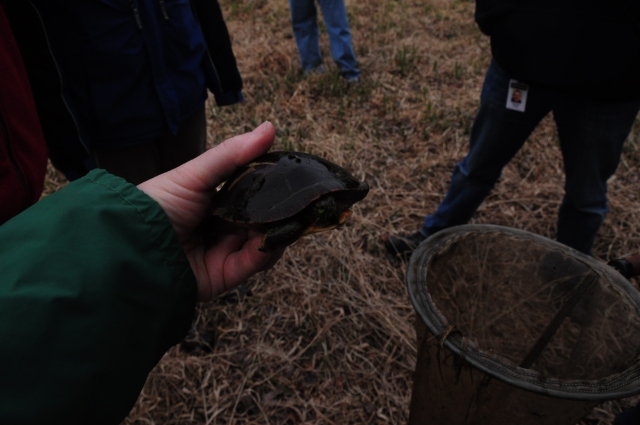 Frogs were everywhere by now and soon containers were full.
Frogs were everywhere by now and soon containers were full.
 On the second night we had close to 40 visitors join us. The sun was out this evening and the frogs turned out to be plentiful all over.
On the second night we had close to 40 visitors join us. The sun was out this evening and the frogs turned out to be plentiful all over.

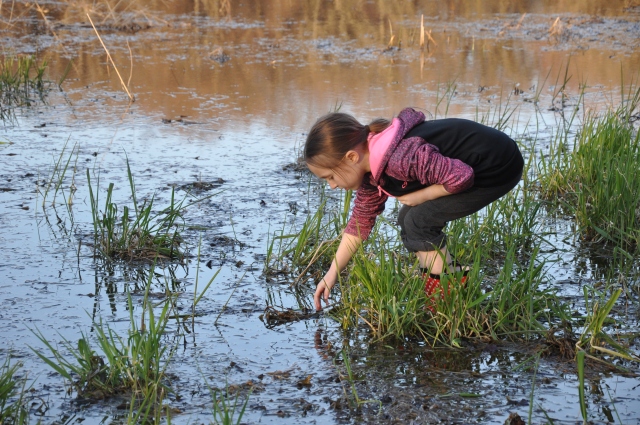 Spring peepers are one of our smallest frogs. They can be very difficult to spot because they blend in so well, but once you catch one, you can easily identify it by the X on its back.
Spring peepers are one of our smallest frogs. They can be very difficult to spot because they blend in so well, but once you catch one, you can easily identify it by the X on its back.
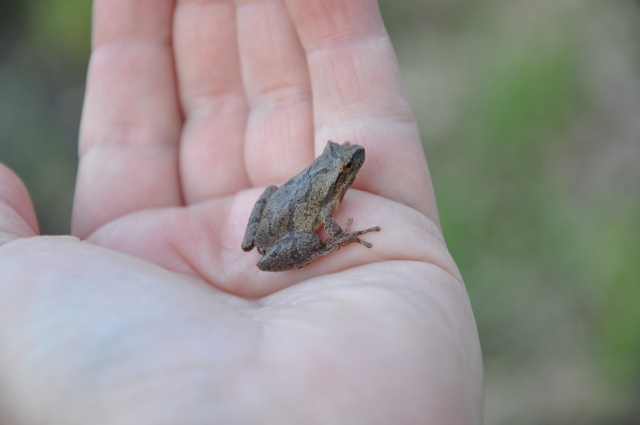
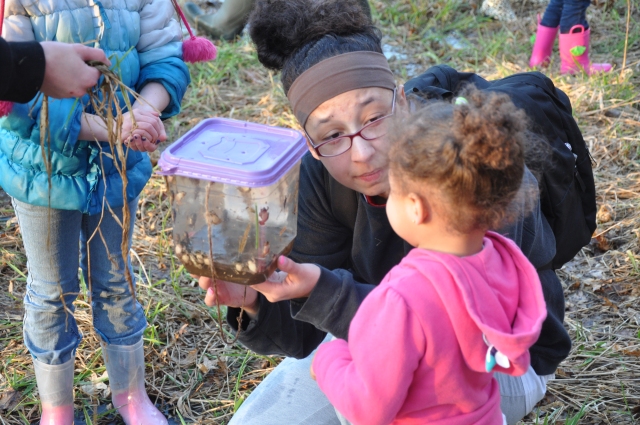 Watch this great video we shot of a little girl catching her very first frog: Girl Catches First Frog
Watch this great video we shot of a little girl catching her very first frog: Girl Catches First Frog
No one knows how to have a good time like we do at Dahlem! Come visit us.
Fifth through eighth graders came out today from a local school to do some aquatic studies. After an indoor crash course in macroinvertebrates and water quality assessment, we divided the group in half and half went to the stream first, while the other half visited the pond first. Later we switched and afterwards we did a wrap-up indoors to evaluate what we found.
My group visited the stream first, and the girls jumped right in!
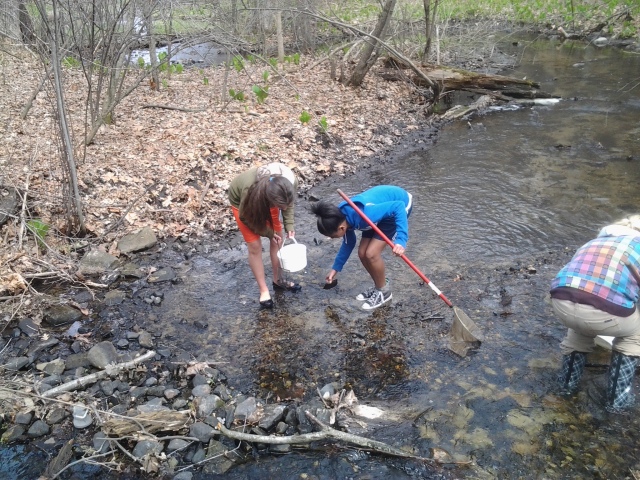
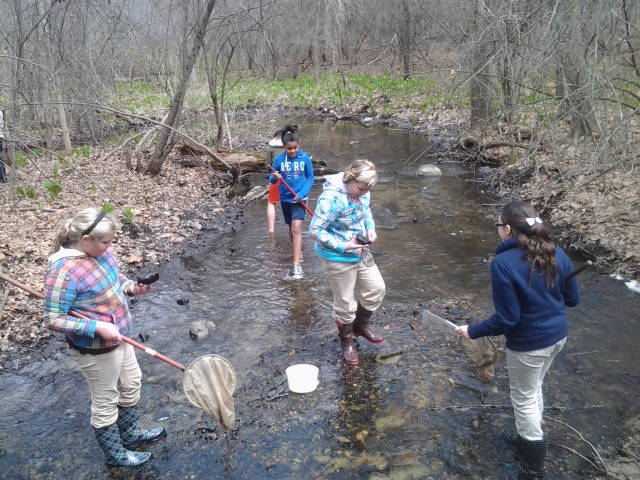 We caught three crayfish – one was under an inch long!
We caught three crayfish – one was under an inch long!
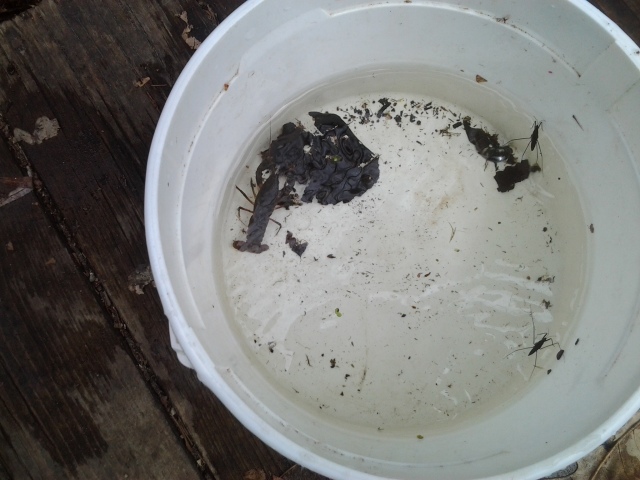
 One student got caught herself – her feet were stuck in the mud and her back and hair were stuck in the brambles!
One student got caught herself – her feet were stuck in the mud and her back and hair were stuck in the brambles!
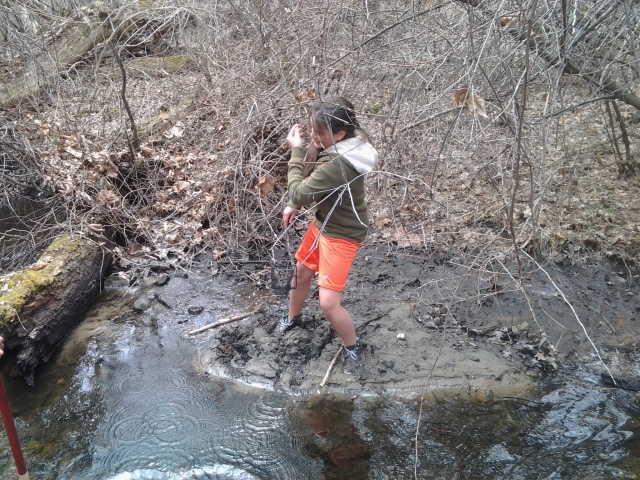 She was a good sport about it, and with the help of two friends in the end, she got unstuck…although one shoe was sucked off her foot!
She was a good sport about it, and with the help of two friends in the end, she got unstuck…although one shoe was sucked off her foot!
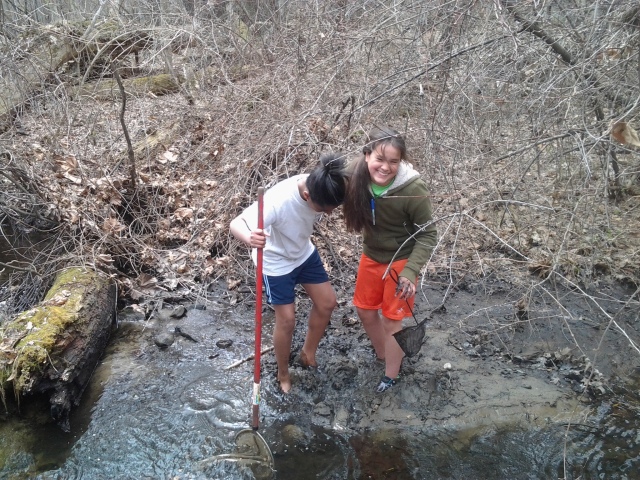
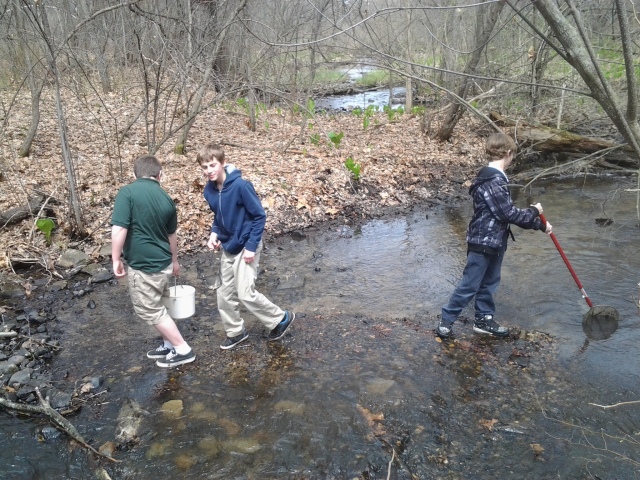 We found many water striders and a good number of caddisfly larvae. We even found a very robust damselfly nymph. All our critters indicated that this was good quality water.
We found many water striders and a good number of caddisfly larvae. We even found a very robust damselfly nymph. All our critters indicated that this was good quality water.
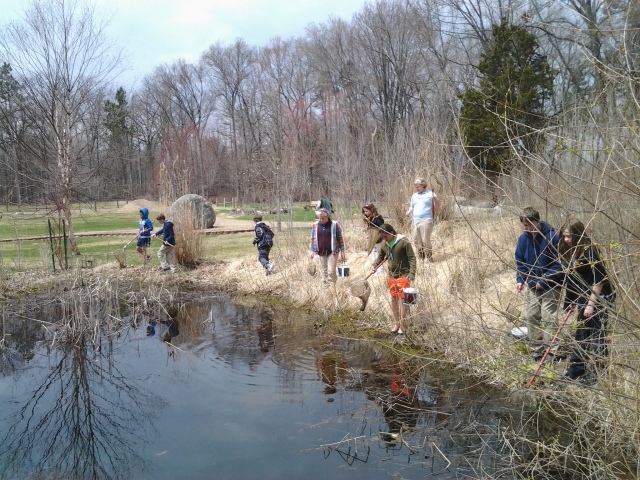
 The air was full of the aroma of decay. This turtle did not make it through the winter, nor did many of the goldfish that live in the pond.
The air was full of the aroma of decay. This turtle did not make it through the winter, nor did many of the goldfish that live in the pond.
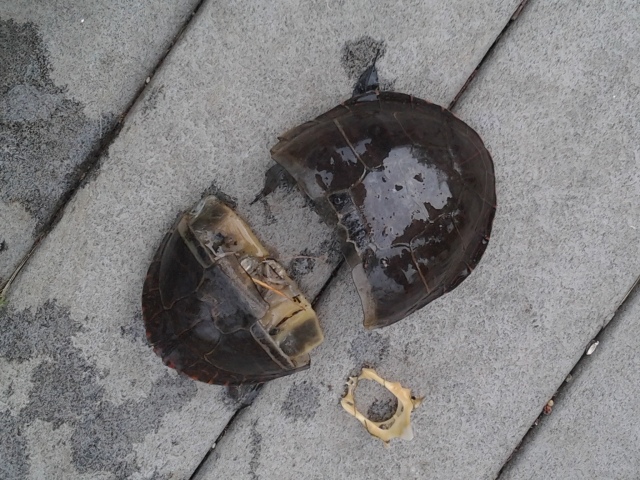 We had some extra time at the end of the program, so the kids got to play in the Nature Playscape. One is never to old to climb trees and play on logs.
We had some extra time at the end of the program, so the kids got to play in the Nature Playscape. One is never to old to climb trees and play on logs.
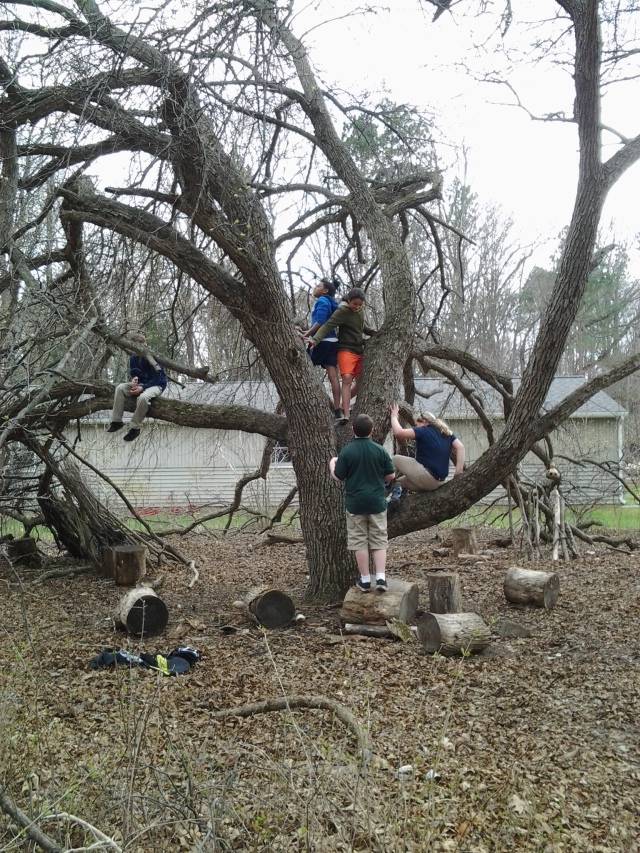
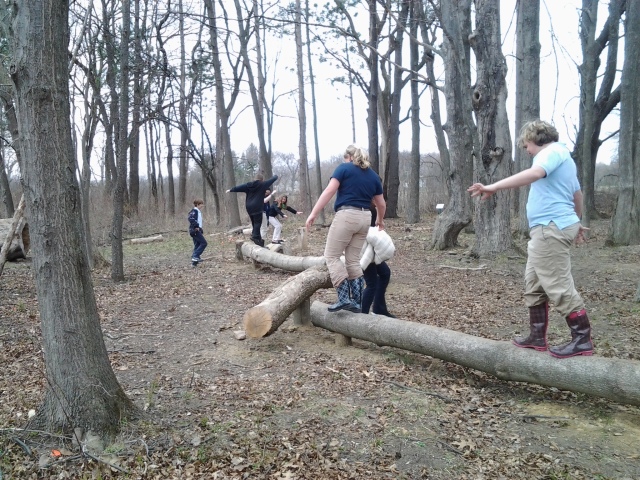
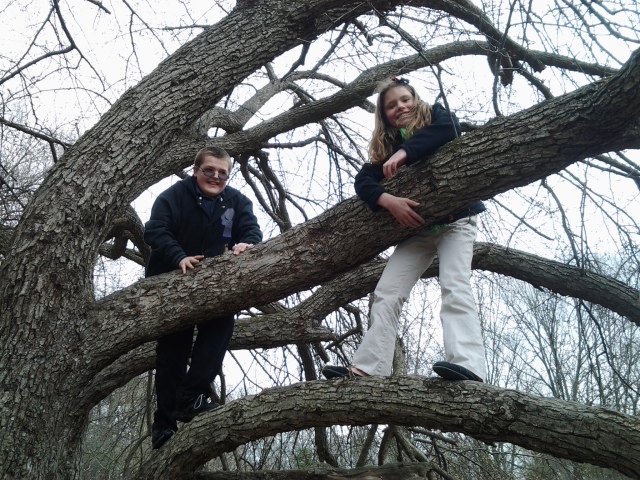 In the end, everyone said it was a great afternoon! We love it when kids love being outside exploring! Let’s hear it for the Salmon in the Classroom kids!
In the end, everyone said it was a great afternoon! We love it when kids love being outside exploring! Let’s hear it for the Salmon in the Classroom kids!
The call came Friday afternoon – the burn crew was going to be here at 6:00 to do the burn we had planned at the north side of our property as part of a land conservation grant that we’ve secured with the Stewardship Network and other partners. Then it was moved to 7:00 – the crew was doing a burn at Haehnle just before coming to Dahlem. About 7:30 we were getting ready to head out to the 10 acre burn site.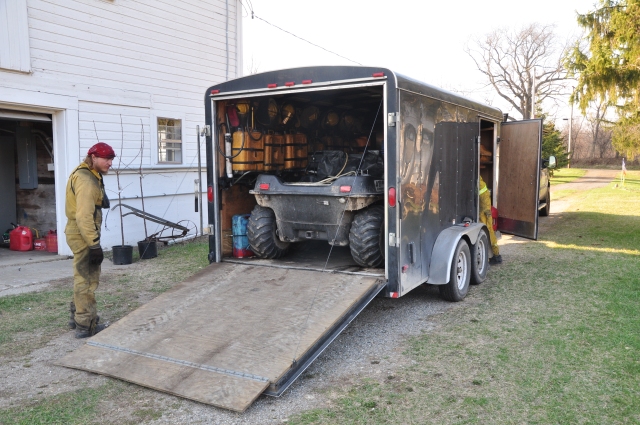
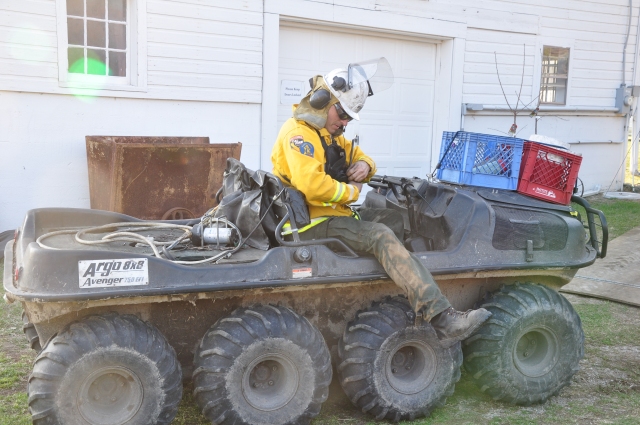 Dave Borneman runs the burn crew. This year’s crew included three new team members, and all were quite efficient and skilled at their work.
Dave Borneman runs the burn crew. This year’s crew included three new team members, and all were quite efficient and skilled at their work.
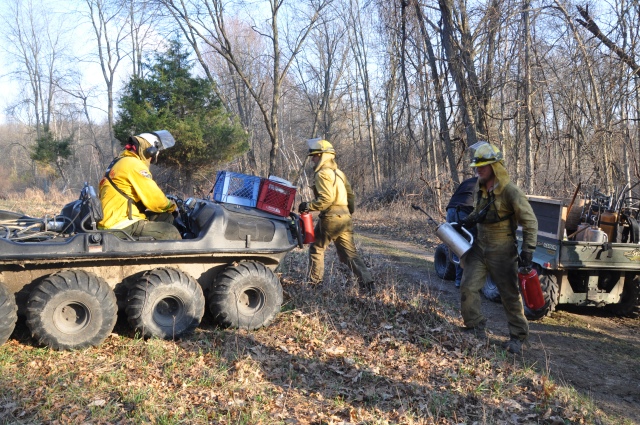 The burn site includes edges (along a field and trails), a somewhat open grassy area, and woods. The wind was coming out of the west, so they started the burn in the woods on the east side of the plot, and drove the flames into the wind. The raked trail served as a fire break.
The burn site includes edges (along a field and trails), a somewhat open grassy area, and woods. The wind was coming out of the west, so they started the burn in the woods on the east side of the plot, and drove the flames into the wind. The raked trail served as a fire break.

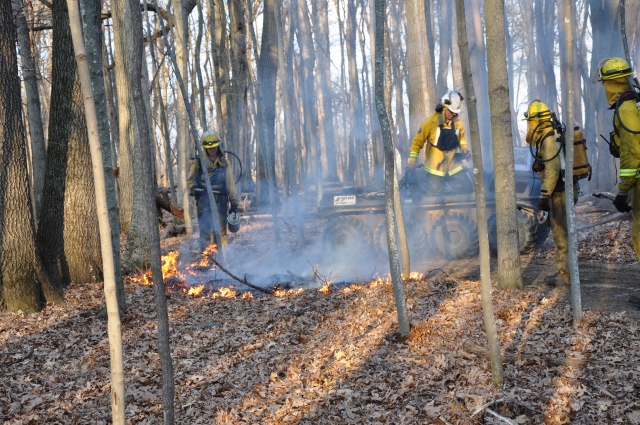
 There wasn’t a lot of fuel in the woods, aside from last fall’s leaves and some old branches, so this area took its time to burn. They laid down several lines of fire to get it burning faster.
There wasn’t a lot of fuel in the woods, aside from last fall’s leaves and some old branches, so this area took its time to burn. They laid down several lines of fire to get it burning faster.
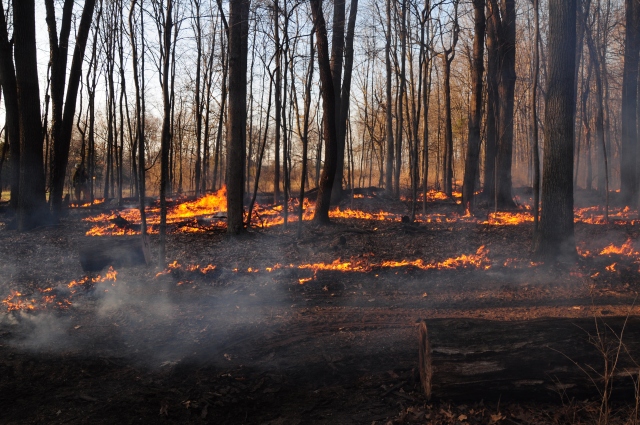 Areas around logs, benches and signs were watered down to prevent them from catching fire.
Areas around logs, benches and signs were watered down to prevent them from catching fire.
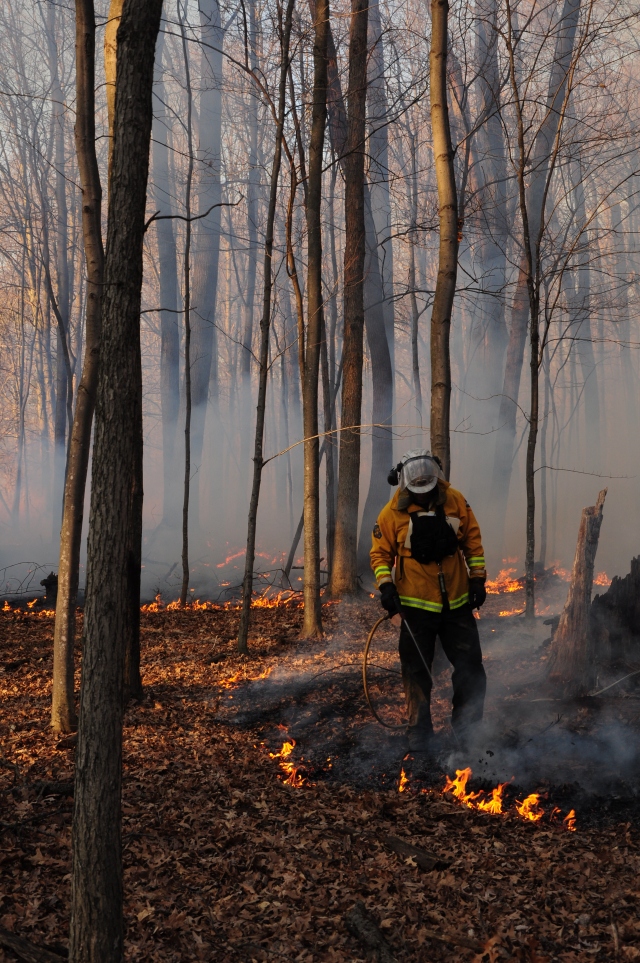
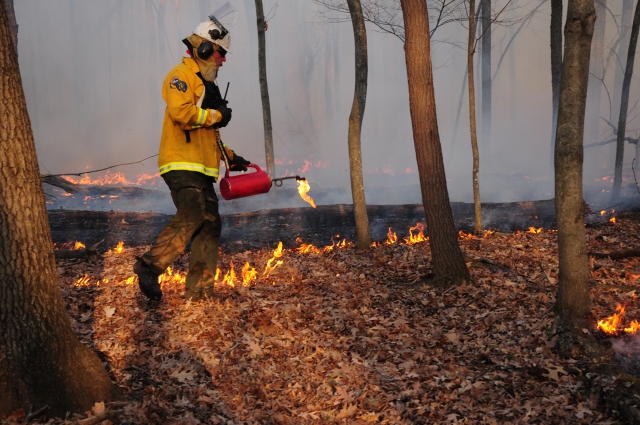 It was a beautiful warm evening, and those flames were good and hot!
It was a beautiful warm evening, and those flames were good and hot!
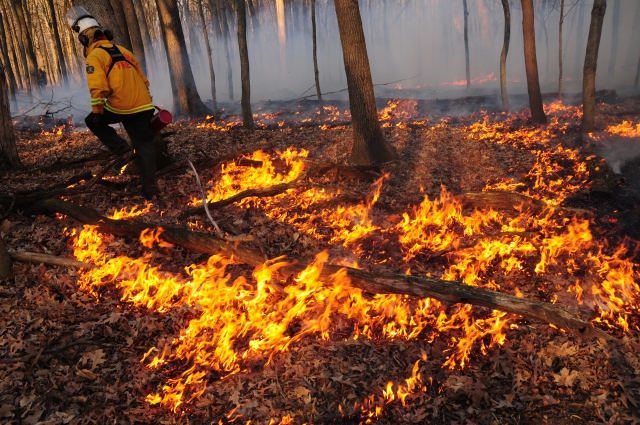 We had a fair-sized crowd of spectators: Dahlem staff, volunteers, members and friends. There was also a reporter and photographer from the local paper in attendance.
We had a fair-sized crowd of spectators: Dahlem staff, volunteers, members and friends. There was also a reporter and photographer from the local paper in attendance.
 Part of the burn crew went up to the northern edge of the area and started sending the flames through the edge and into the open area.
Part of the burn crew went up to the northern edge of the area and started sending the flames through the edge and into the open area.
 A lot of the grass here did not burn. And the brush piles resisted the flames as well. This area had been prepped by our Cut and Dab Society (volunteers who help us with land conservation/stewardship projects), mostly this spring. The deep snows, and later the ice, from the winter prevented a lot of work that would’ve been done over the winter months. As a result, much of the brush in the brush piles was still on the green side.
A lot of the grass here did not burn. And the brush piles resisted the flames as well. This area had been prepped by our Cut and Dab Society (volunteers who help us with land conservation/stewardship projects), mostly this spring. The deep snows, and later the ice, from the winter prevented a lot of work that would’ve been done over the winter months. As a result, much of the brush in the brush piles was still on the green side.
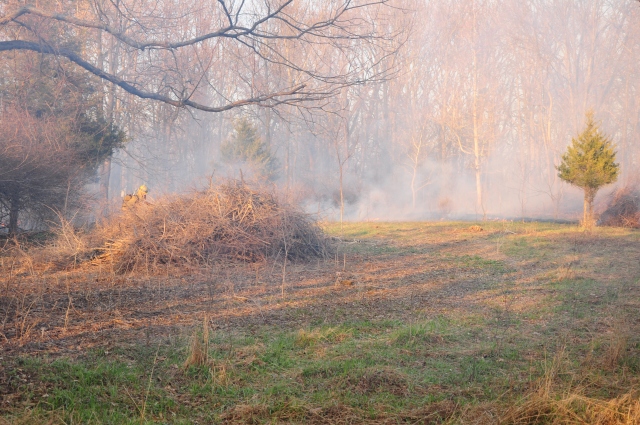
One brush pile, however, had some dead material in it, and it burned quite nicely once it got going.

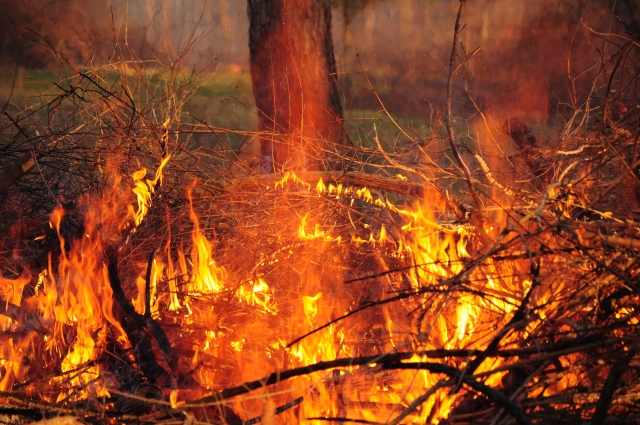 Still Life with Vine. We discovered that the cut vines (mostly Asian bittersweet) burned really well.
Still Life with Vine. We discovered that the cut vines (mostly Asian bittersweet) burned really well.
 Here we are looking back across the open area toward the woods. A little further back from this shot is the glacial pond, which was alive with singing frogs. They were not at all deterred by the smoke that was blowing their way.
Here we are looking back across the open area toward the woods. A little further back from this shot is the glacial pond, which was alive with singing frogs. They were not at all deterred by the smoke that was blowing their way.
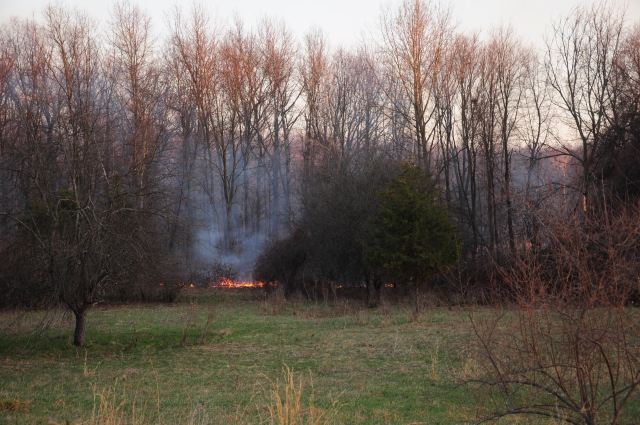 Dusk was well underway by now, so Dave drove back and forth with a drip torch, making sure there were plenty of lines of fire going to speed the burn along.
Dusk was well underway by now, so Dave drove back and forth with a drip torch, making sure there were plenty of lines of fire going to speed the burn along.
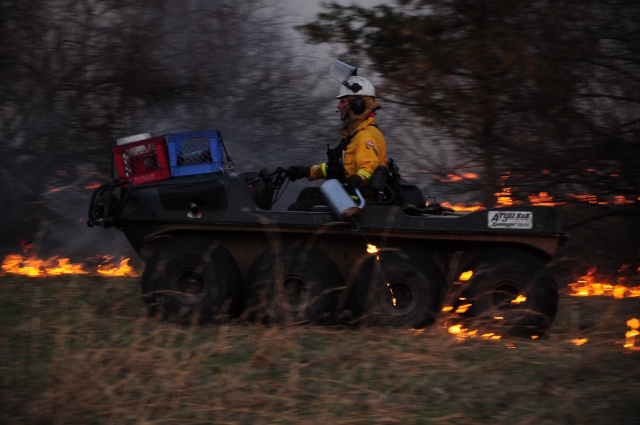 At last we were on the western side of the plot. The trail that leads to the Ecology Farm formed the boundary along this side.
At last we were on the western side of the plot. The trail that leads to the Ecology Farm formed the boundary along this side.
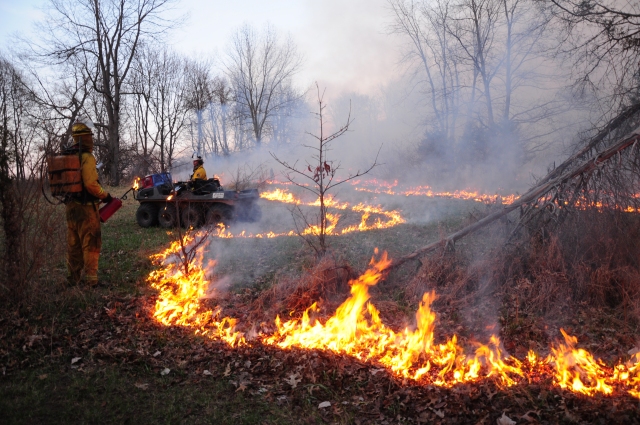 As mentioned before, the vines burned very nicely.
As mentioned before, the vines burned very nicely.

 The lines of fire were beautiful as evening fell.
The lines of fire were beautiful as evening fell.
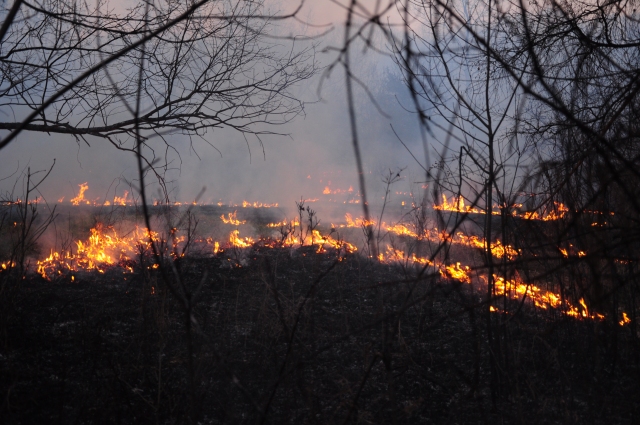
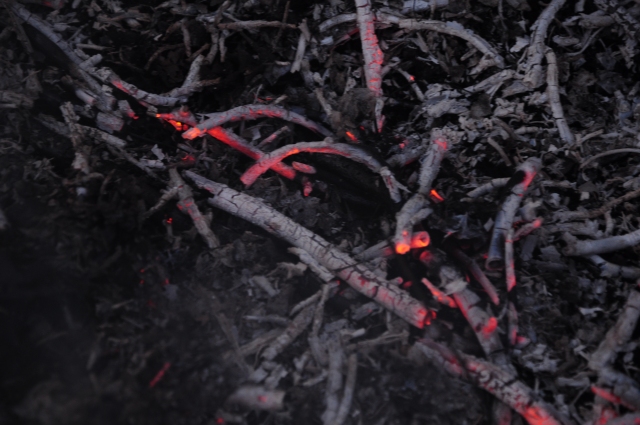 In truth, the world did not turn blue; it is the result of me shooting at a very low shutter speed. This shot, which was taken about 9:00 PM, shows an interesting web of unburned grasses through the open area. These are likely deer trails.
In truth, the world did not turn blue; it is the result of me shooting at a very low shutter speed. This shot, which was taken about 9:00 PM, shows an interesting web of unburned grasses through the open area. These are likely deer trails. So…why was this burn prescribed? Once upon a time, burns were a natural part of the landscape, often started by lightning strikes, and later encouraged by the Native Americans. Burns are what keep grasslands and savannas as grasslands and savannas. Without some sort of disturbance (like fire), ecosystems age and change over time, eventually reaching whatever the climax community of that area is. By reintroducing fire to the landscape, we can keep our grasslands and savannas from becoming woodlands. This favors plant, bird, insect, mammal, and herp (reptile/amphibian) species that thrive in open situations (or along edges). Without disturbances, like fire, diversity on the landscape is lost.
So…why was this burn prescribed? Once upon a time, burns were a natural part of the landscape, often started by lightning strikes, and later encouraged by the Native Americans. Burns are what keep grasslands and savannas as grasslands and savannas. Without some sort of disturbance (like fire), ecosystems age and change over time, eventually reaching whatever the climax community of that area is. By reintroducing fire to the landscape, we can keep our grasslands and savannas from becoming woodlands. This favors plant, bird, insect, mammal, and herp (reptile/amphibian) species that thrive in open situations (or along edges). Without disturbances, like fire, diversity on the landscape is lost.
At Dahlem, we are working on a long-range plan to re-establish habitats that favor grassland birds, whose populations are in serious decline (due to a number of reason). By recreating open habitats, such as grasslands and savannas, we are providing nesting habitat for these birds (and other associated species).
We are quite keen to see what plant species pop up in the burn area. While we will be planting some grass and forb seeds, it is very possible that some natives were already in the seed bank and will have been released by the fire.
Be sure to walk out to the burn over the next few weeks to see what is happening!
On Saturday, Marcy 29, Allen Chartier was back at Dahlem doing another bird banding program, this time for the public. Nearly 40 visitors came to watch and help release birds. Here are some of the highlights.
 Watching to see what’s caught in the nets.
Watching to see what’s caught in the nets.
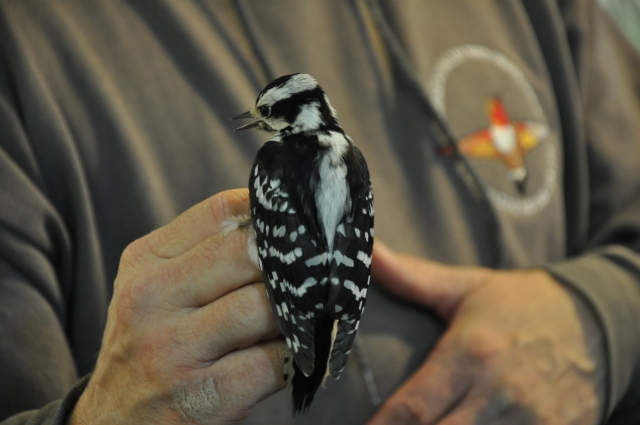
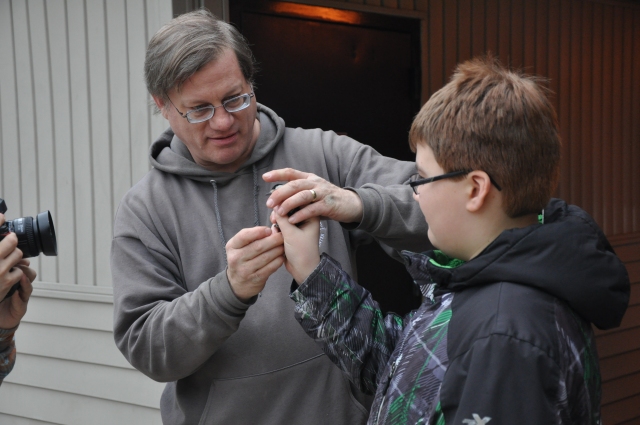
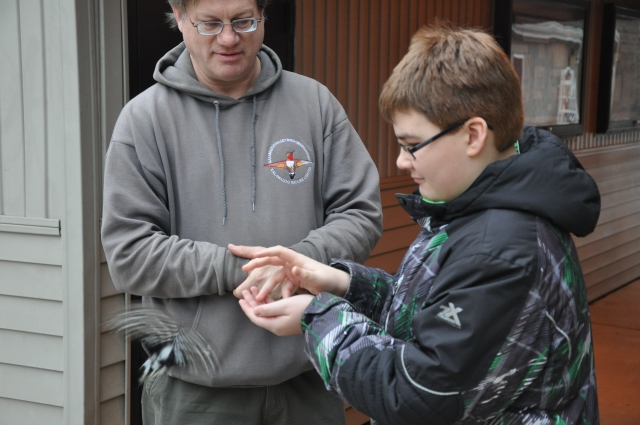
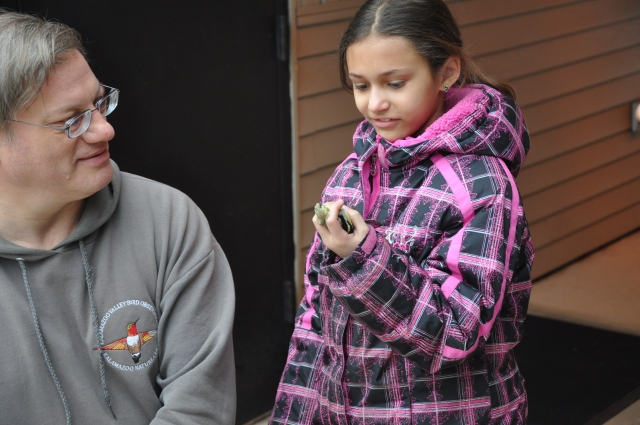

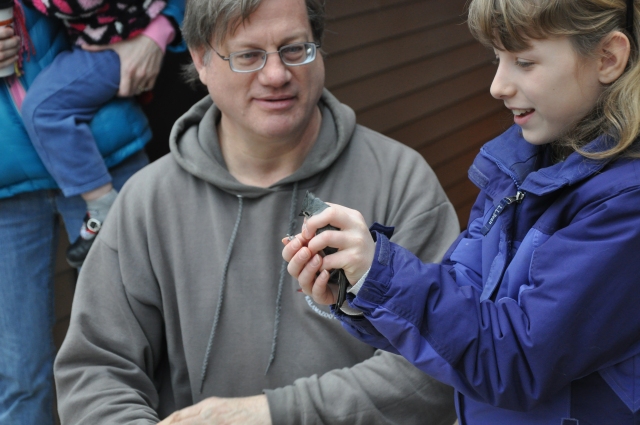



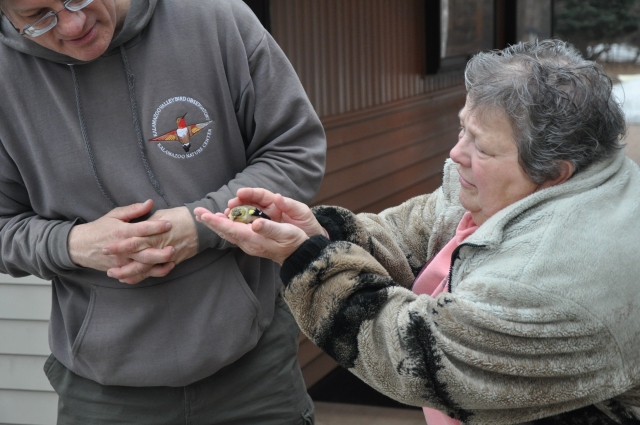
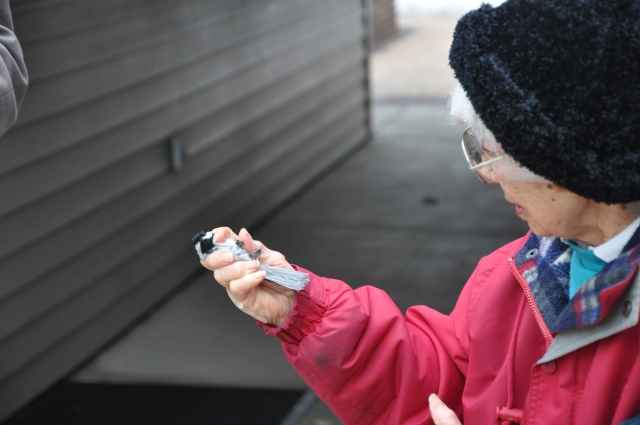
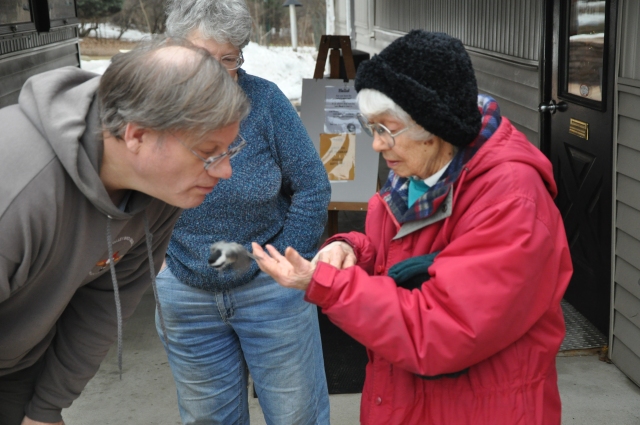

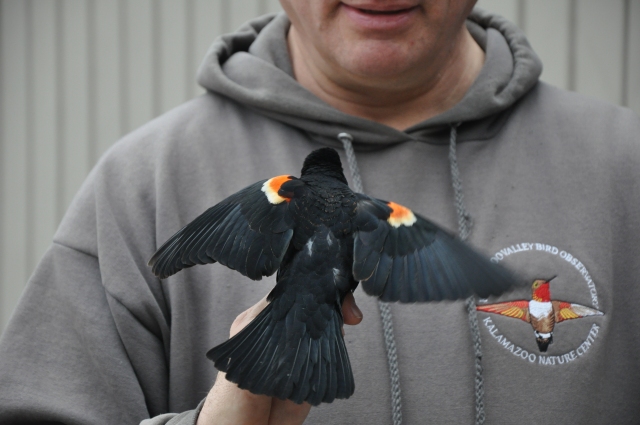



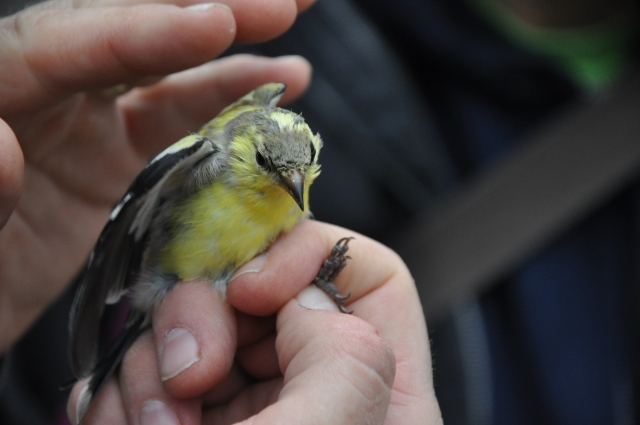



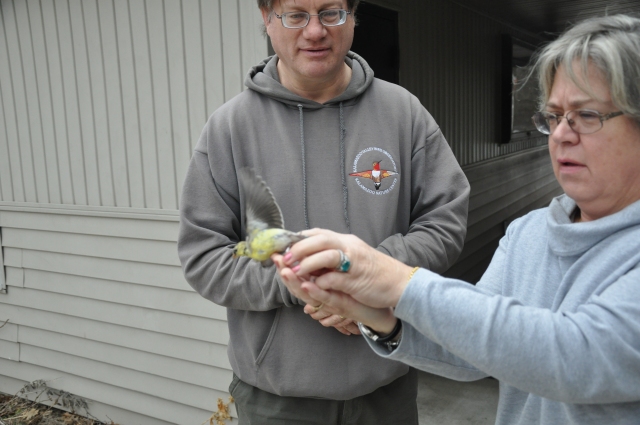
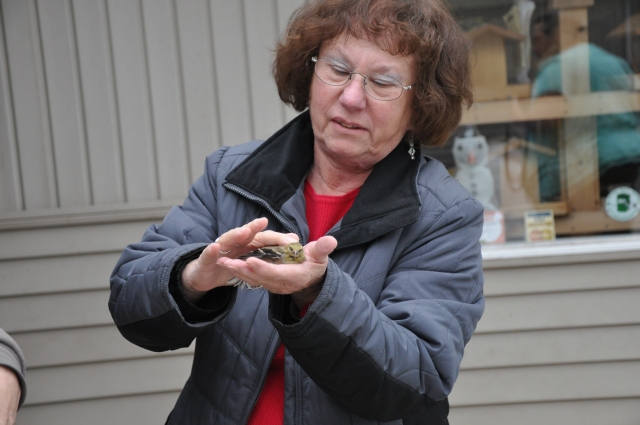


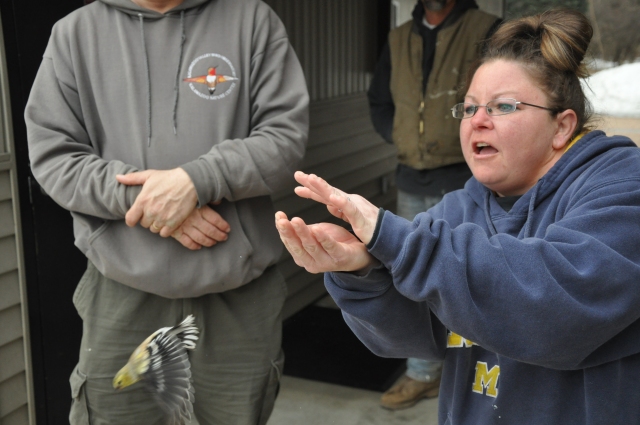 Everyone had a great time, and everyone who wanted to release a bird had the chance to do so.
Everyone had a great time, and everyone who wanted to release a bird had the chance to do so.
If you’d like to see more of this kind of program, let us know! It’s a great way to introduce people of all ages to birds (up close) and nature (in general).